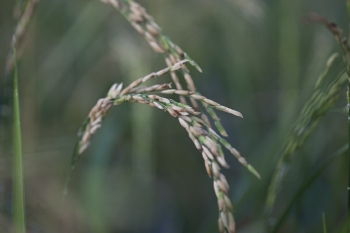COVER STORY
(Page 3 of 6)Rice is the staple crop for more than half the world's population, including the majority of the world's poorest, providing more than one-fifth of global calories consumed. But it will have to be grown differently to meet the caloric needs of a global population that is projected to hit 9 billion by 2050, McCouch emphasizes. Rapid climate change poses additional hurdles, as heat, drought and lack of fresh water will require people to rethink how rice has been grown for thousands of years.

A close look at rice plants' seeds and panicles in a Cornell greenhouse. See larger image
"There's a global imperative to double the production of cereal crops in the next 20 to 50 years," says McCouch.
Using the modern tools of cutting-edge genomics to access and track ancient variations, breeders are developing new varieties in just a few years, as opposed to a dozen years that traditional breeding methods required. Nor is this using the tools of genetic engineering, involving the insertion of genes from any species into an organism. Instead, McCouch uses traditional methods, where breeders mate or cross sexually compatible species and then select favorable offspring.
Challenges to rice
The green revolution of the latter half of the 20th century improved rice yields by two to three times over traditional rice varieties while tailoring plants to grow under very specific conditions of irrigation using large applications of synthetic fertilizers and pesticides. This system, it's now realized, harms the environment, is too expensive for poor farmers and requires the use of diminishing supplies of costly fossil fuels.
As a result, rice today faces a number of challenges. The future will require crops that produce more grain on less land as human populations encroach on arable farmland. Already, 30 percent of the world's total land area is inadequate for crops due to the triple threat of soil acidity, aluminum toxicity and phosphorus deficiency.
As climate changes projected for this century bring heat and precipitation shifts, and as humans draw more and more water out of underground reserves, lack of fresh water will soon force rice growers to abandon the paddy system that has controlled weeds for thousands of years. Why, then, not use herbicides and genetically engineer rice to withstand the chemicals? Ineffective, because the major weed in a rice field – wild rice – is sexually compatible with the crop, so genes transfer immediately to the weeds, making them also herbicide tolerant.
Instead, breeders must develop new rice that grows in dryer soils, with deeper taproots that search for scarce water, and shoots that use water efficiently within the plant. "We need to understand the entire root system, and the way roots take up nutrients and water, as part of that big global picture," McCouch says.
With these problems, and with a narrow window of time, researchers across several disciplines must turn to a new agricultural revolution, learning to combine genes in new ways and taking advantage of the power of genomics to do so efficiently.
<<View entire story as one page>>